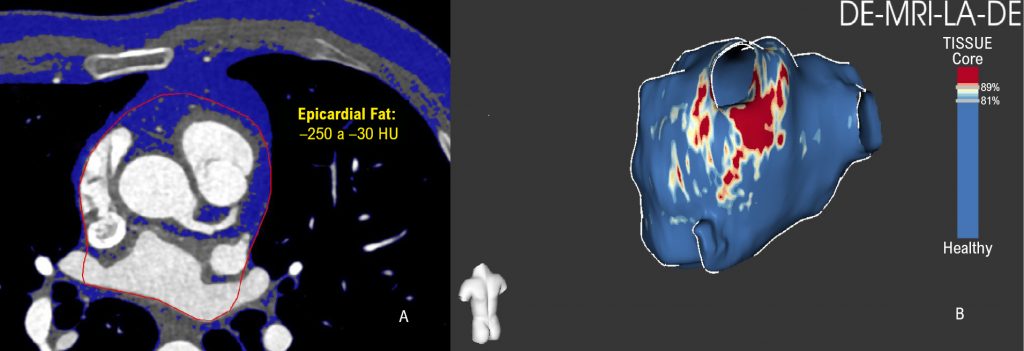Arq. Bras. Cardiol. 2022; 118(4): 737-742
The Relationship between Epicardial Fat and Atrial Fibrillation Cannot Be Fully Explained by Left Atrial Fibrosis
This Original Article is referred by the Short Editorial "Obesity and Epicardial Fat Associated with Higher Atrial Fibrillation Recurrence After Ablation: Just Coincidence?".
Abstract
Background
Epicardial adipose tissue (EAT) has been associated with atrial fibrillation (AF), but its pathophysiological mechanisms remain unclear.
Objectives
To measure the correlation between EAT and left atrium (LA) fibrosis, and to assess their ability to predict relapse after pulmonary vein isolation (PVI).
Methods
Patients with AF enrolled for a first PVI procedure underwent both cardiac computerized tomography (CT) and cardiac magnetic resonance (CMR) imaging within less than 48 hours. EATLMwas quantified on contrast-enhanced CT images at the level of the left main. LA fibrosis was quantified on isotropic 1.5 mm 3D delayed enhancement CMR. After pulmonary vein isolation (PVI), patients were followed up for AF relapse. Statistical significance was set at p<0.05.
Results
Most of the 68 patients (46 men, age 61±12 years) had paroxysmal AF (71%, n=48). Patients had a median EATLMvolume of 2.4 cm3/m2(interquartile range [IQR] 1.6–3.2 cm3/m2), and a median amount of LA fibrosis of 8.9 g (IQR 5–15 g). The correlation between EATLMand LA fibrosis was statistically significant but weak (Spearman’s R=0.40, p=0.001). During a median follow-up of 22 months (IQR 12–31), 31 patients (46%) had AF relapse. Multivariate analysis yielded two independent predictors of AF relapse: EATLM(HR 2.05, 95% CI 1.51–2.79, p<0.001), and non-paroxysmal AF (HR 2.36, 95% CI 1.08–5.16, p=0.031).
Conclusion
The weak correlation between EAT and LA suggests that LA fibrosis is not the main mechanism linking EAT and AF. EAT was more strongly associated with AF relapse than LA fibrosis, supporting the existence of other more important mediators of EAT and AF.
894

